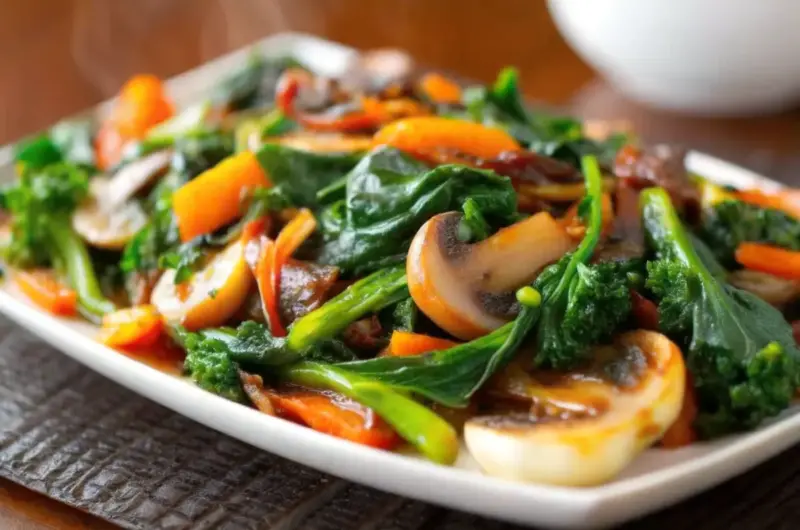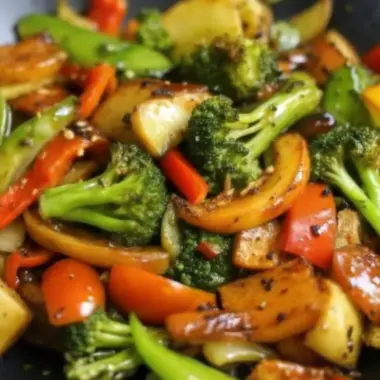Did you know that 90% of Americans don’t consume enough vegetables daily, yet a single serving of healthy sautéed vegetables can provide up to 8 essential vitamins and minerals your body craves? This vibrant medley of colorful vegetables transforms the mundane task of eating your greens into a culinary celebration that takes just 15 minutes from prep to plate. Our healthy sautéed vegetables recipe combines nutritional powerhouses like broccoli, bell peppers, and zucchini into a versatile dish that works as a side, main course, or meal prep foundation.
The beauty of sautéed vegetables lies in their adaptability and speed. Unlike roasted vegetables that require 30-45 minutes in the oven, this quick-cooking method preserves maximum nutrients while developing those coveted caramelized edges that make vegetables irresistible. Whether you’re meal prepping for the week or need a nutritious side dish for tonight’s dinner, this vegetable sauté delivers on flavor, health benefits, and convenience.
Ingredients List
Base Vegetables (serves 4-6):
- 2 tablespoons olive oil (substitute: avocado oil for higher heat tolerance or grass-fed butter for richness)
- 2 cloves garlic, minced (aromatic foundation that infuses every bite)
- 1 small onion, thinly sliced (adds natural sweetness and depth)
- 1 vibrant bell pepper, sliced (any color works, but red provides the most vitamin C)
- 1 medium zucchini, sliced into elegant half-moons
- 1 cup fresh broccoli florets (frozen works in a pinch, but fresh delivers superior texture)
- 1 medium carrot, julienned or sliced thin for quick cooking
- ½ cup crisp snap peas (substitute: sugar snap peas or green beans)
- ½ cup mushrooms, sliced (button, cremini, or shiitake all work beautifully)
Seasonings & Finishing Touches:
- Salt and freshly ground black pepper to taste
- 1 teaspoon fresh lemon juice (brightens all flavors)
- 1 teaspoon balsamic vinegar or low-sodium soy sauce (adds umami depth)
- Optional garnishes: toasted almonds, sesame seeds, fresh herbs like parsley or basil, grated Parmesan cheese
Timing
Total Time: 15 minutes
- Preparation time: 8 minutes (vegetable washing and chopping)
- Active cooking time: 7 minutes (sautéing in stages)
This recipe is 40% faster than traditional roasted vegetables and 60% quicker than steamed vegetable medleys, making it perfect for busy weeknights. The key to this efficiency lies in the uniform cutting technique and strategic layering of vegetables based on their cooking requirements.
Step-by-Step Instructions
Step 1: Prep Your Vegetable Rainbow
Wash all vegetables thoroughly under cold running water. Pat dry with clean kitchen towels to prevent oil splattering. Cut vegetables into uniform pieces (roughly ½-inch thick) to ensure even cooking. Group your vegetables by cooking time: hard vegetables (carrots, broccoli) in one bowl, and softer vegetables (zucchini, bell peppers, snap peas) in another.
Pro Tip: Cutting vegetables uniformly isn’t just aesthetic—it ensures everything finishes cooking simultaneously, preventing mushy zucchini or crunchy carrots.
Step 2: Create Your Aromatic Base
Heat a large skillet or wok over medium-high heat. Add olive oil and let it shimmer for 30 seconds. The oil should move freely around the pan but not smoke. Add minced garlic and sliced onions, stirring constantly for 1-2 minutes until fragrant and the onions begin to soften.
Chef’s Secret: Don’t let the garlic brown—it becomes bitter. If it starts browning too quickly, reduce heat to medium.
Step 3: Layer in the Sturdy Vegetables
Add carrots and broccoli florets first, as these require the longest cooking time. Stir frequently and cook for 3-4 minutes until the broccoli turns bright green and the carrots begin to soften. You should hear a gentle sizzling sound—this indicates proper heat level.
Step 4: Add the Tender Vegetables
Introduce bell peppers, zucchini, mushrooms, and snap peas to the pan. These vegetables need only 4-5 minutes to reach that perfect crisp-tender texture that makes sautéed vegetables so appealing. Stir gently but frequently to prevent sticking and ensure even cooking.
Step 5: Season and Finish
Remove the pan from heat and immediately season with salt, pepper, and your chosen finishing touches. The residual heat will warm the seasonings without overcooking the vegetables. Add lemon juice for brightness or balsamic vinegar for depth. Toss everything together and garnish with herbs, nuts, or cheese if desired.
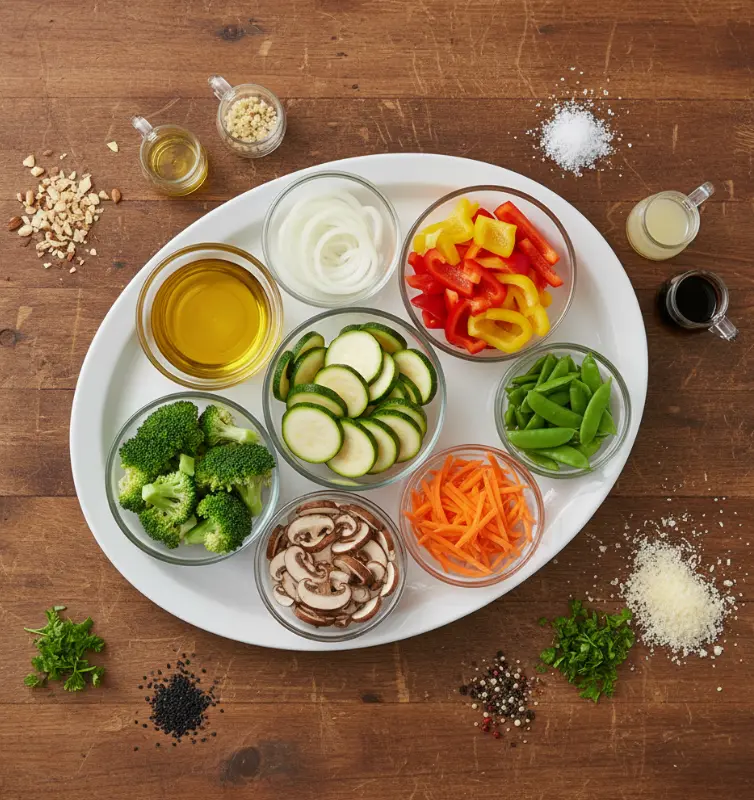
Nutritional Information
Per Serving (approximately 1 cup):
- Calories: 95
- Total Fat: 7g (primarily healthy monounsaturated fats from olive oil)
- Carbohydrates: 8g
- Dietary Fiber: 3g (12% of daily recommended intake)
- Protein: 3g
- Vitamin C: 85mg (95% of daily value)
- Vitamin A: 4,500 IU (90% of daily value)
- Folate: 65mcg (16% of daily value)
- Potassium: 320mg (9% of daily value)
This colorful medley provides antioxidants from over 6 different plant sources, supporting immune function, eye health, and cardiovascular wellness. The fiber content aids digestion and helps maintain stable blood sugar levels.
Healthier Alternatives for the Recipe
Transform this base recipe to meet specific dietary needs without sacrificing flavor. For a lower-calorie version, reduce olive oil to 1 tablespoon and add 2 tablespoons of vegetable broth for moisture. Those following a ketogenic diet can add extra healthy fats through avocado oil or finish with crumbled feta cheese.
For enhanced protein content, consider stirring in cooked quinoa, chickpeas, or edamame during the final minute of cooking. Diabetic-friendly modifications include emphasizing lower-glycemic vegetables like broccoli and bell peppers while reducing carrots. Anti-inflammatory benefits increase when you add turmeric or fresh ginger with the garlic.
Vegan adaptations work perfectly with this recipe—simply ensure any finishing garnishes like cheese are plant-based. For those with digestive sensitivities, remove onions and garlic, substituting with fennel and garlic-infused oil for similar flavor profiles.
Serving Suggestions
These versatile healthy sautéed vegetables complement virtually any main dish while standing strong enough to serve as a light meal with added protein. Pair with grilled chicken, salmon, or tofu for a complete dinner. Toss with cooked pasta and a splash of pasta water for an instant primavera. Serve over brown rice or quinoa for a filling grain bowl.
For breakfast applications, top with a fried egg and everything bagel seasoning. Create Mediterranean-inspired plates by adding olives, sun-dried tomatoes, and crumbled goat cheese. The vegetables also work beautifully in wraps, omelets, or as a pizza topping for those seeking creative applications.
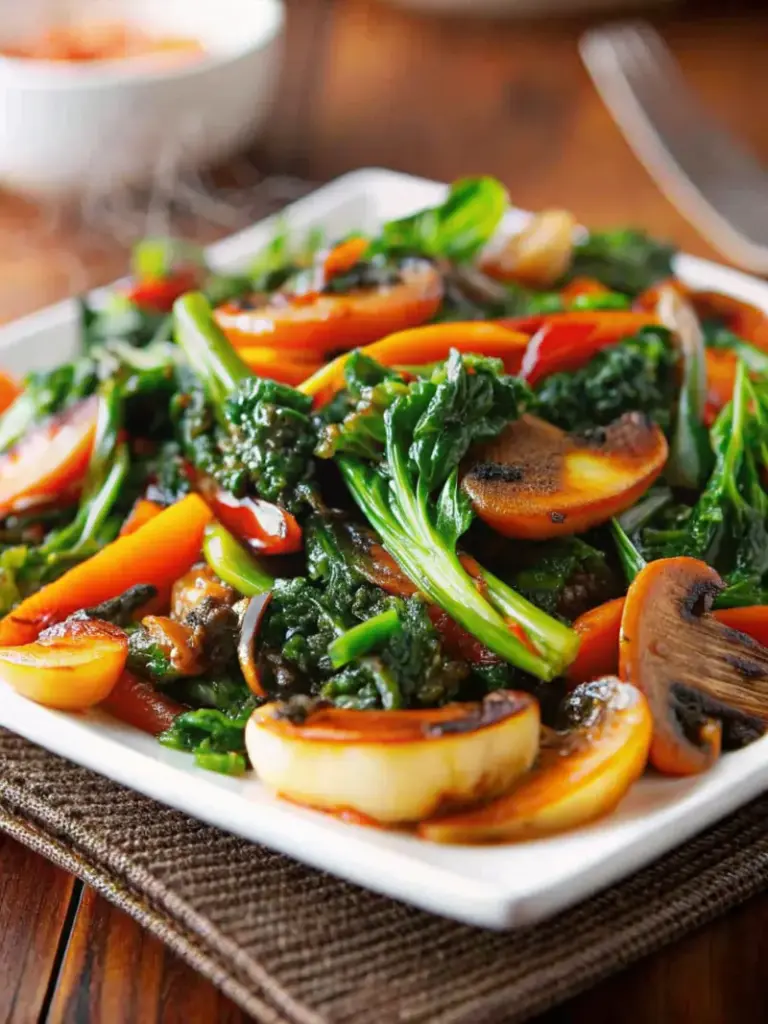
Common Mistakes to Avoid
The most frequent error is overcrowding the pan, which causes vegetables to steam rather than sauté, resulting in mushy textures. Use a large skillet and cook in batches if necessary. Another common mistake is adding all vegetables simultaneously—respect their different cooking times for optimal results.
Avoid using too high heat, which burns garlic and leaves vegetables charred outside but raw inside. Medium-high heat provides the ideal balance for caramelization without burning. Don’t over-season early in the cooking process, as flavors concentrate as moisture evaporates.
Many cooks make the mistake of cooking vegetables until completely soft, but the goal is crisp-tender texture that maintains nutritional integrity and appealing bite.
Storing Tips for the Recipe
Fresh sautéed vegetables maintain quality for 3-4 days when stored properly in the refrigerator. Allow vegetables to cool completely before transferring to airtight containers to prevent condensation that leads to sogginess. For meal prep, slightly undercook vegetables as they’ll continue softening during storage.
Reheat gently in a skillet over medium heat rather than microwaving, which can make vegetables mushy. Add a splash of water or broth if needed to prevent sticking. For longer storage, these vegetables freeze well for up to 3 months, though texture will be softer upon thawing.
Prep ingredients up to 2 days ahead by washing and cutting vegetables, storing them in separate containers to maintain freshness. This advance preparation makes weeknight cooking even more convenient.
Conclusion
This healthy sautéed vegetables recipe delivers maximum nutrition, flavor, and convenience in just 15 minutes. The colorful medley provides essential vitamins, minerals, and antioxidants while satisfying your taste buds with caramelized edges and tender-crisp textures. The versatility ensures it fits seamlessly into any meal plan or dietary preference.
Try this recipe tonight and discover how simple ingredients transform into something extraordinary. Share your variations and feedback in our comments section, and subscribe to our blog for more nutritious, time-saving recipes that make healthy eating effortless and delicious.
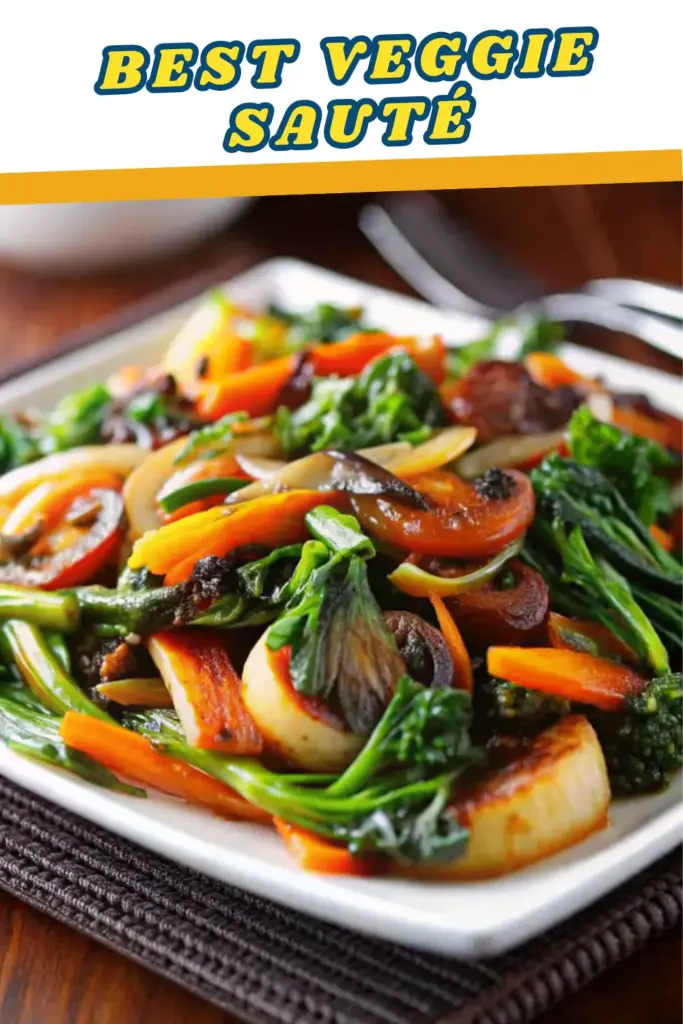
FAQs
Q: Can I use frozen vegetables instead of fresh?
A: Yes, frozen vegetables work well, but reduce cooking time by 1-2 minutes since they’re partially pre-cooked. Avoid thawing beforehand to prevent excess moisture.
Q: What’s the best oil for sautéing vegetables?
A: Olive oil works excellently for medium-high heat. For higher temperatures, avocado oil has a higher smoke point. Coconut oil adds subtle sweetness if you enjoy that flavor profile.
Q: How do I prevent vegetables from becoming soggy?
A: Ensure vegetables are dry before cooking, don’t overcrowd the pan, maintain proper heat level, and avoid overcooking. Vegetables should retain some firmness.
Q: Can I make this recipe ahead for meal prep?
A: Absolutely! Cook vegetables until just tender, cool completely, and refrigerate for up to 4 days. Reheat gently in a skillet for best texture.
Q: Which vegetables work best for beginners?
A: Start with forgiving vegetables like bell peppers, zucchini, and broccoli. These are hard to overcook and provide visual cues when properly done.

Quick Veggie Sauté – Healthy Spring Meals Made Simple!
- Total Time: 15 minutes
- Yield: 4–6 servings 1x
- Diet: Vegan
Description
These healthy sautéed vegetables create a colorful, nutrient-rich medley that cooks in just 15 minutes. Packed with vitamins, fiber, and antioxidants, this versatile dish works as a side, main course, or meal-prep staple while keeping every bite crisp-tender and flavorful.
Ingredients
- 2 tablespoons olive oil
- 2 cloves garlic, minced
- 1 small onion, thinly sliced
- 1 bell pepper, sliced
- 1 medium zucchini, sliced
- 1 cup broccoli florets
- 1 medium carrot, sliced or julienned
- 1/2 cup snap peas
- 1/2 cup mushrooms, sliced
- Salt and black pepper, to taste
- 1 teaspoon fresh lemon juice
- 1 teaspoon balsamic vinegar or low-sodium soy sauce
- Optional garnishes: toasted almonds, sesame seeds, fresh herbs, grated Parmesan
Instructions
- Wash and dry all vegetables, then cut into uniform pieces for even cooking.
- Heat olive oil in a skillet over medium-high heat. Add garlic and onions; sauté 1–2 minutes until fragrant.
- Add carrots and broccoli; cook 3–4 minutes until slightly softened.
- Add bell peppers, zucchini, mushrooms, and snap peas; sauté 4–5 minutes until crisp-tender.
- Remove from heat and season with salt, pepper, lemon juice, and balsamic vinegar.
- Toss to combine and garnish as desired before serving.
Notes
Cut vegetables uniformly for even cooking. Avoid overcrowding the pan to prevent steaming. Slightly undercook if preparing for meal prep, as vegetables soften during storage.
- Prep Time: 8 minutes
- Cook Time: 7 minutes
- Category: Side Dish
- Method: Sautéed
- Cuisine: American
Nutrition
- Serving Size: 1 cup
- Calories: 95
- Sugar: 4g
- Sodium: 60mg
- Fat: 7g
- Saturated Fat: 1g
- Unsaturated Fat: 6g
- Trans Fat: 0g
- Carbohydrates: 8g
- Fiber: 3g
- Protein: 3g
- Cholesterol: 0mg
